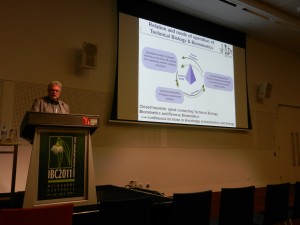International Botanical Congress
29. Juli 2011 von OS
Plants as concept generators for biomimetic materials and structures with hierarchical organization
Organized in co-operation with the Competence Networks Biomimetics, BIOKON e.V., and BIONA by Thomas Speck & Tom Masselter
 In the course of evolution, plants have developed a hierarchically organization on at least five levels: in the stem, the tissues, the cells, the cell wall structure and the biochemical level. These hierarchies are also expressed by gradients in the tissues and the presence of sublevels (e.g. groups of fibrous bundles-fibrous bundles-fibers) and hold responsible for beneficial mechanical properties like a benign fracture behavior, an optimized vibration damping or impact damping, high bending stiffness, heat insulation, avoidance of notch stresses and delamination as well as actuation and self-adaptation properties. Therefore, analyzing the hierarchical organization in plants is a major key toward understanding the morphological-mechanical relationships in the natural structures and for assessing the potential for technical implementation. Over the last few years, it has been shown in a multitude of biomimetic projects that such a translation into technical products is feasible. However, the hierarchical organization that is found in the biological concept generators has only been incorporated in a small part of technical materials and structures.
In the course of evolution, plants have developed a hierarchically organization on at least five levels: in the stem, the tissues, the cells, the cell wall structure and the biochemical level. These hierarchies are also expressed by gradients in the tissues and the presence of sublevels (e.g. groups of fibrous bundles-fibrous bundles-fibers) and hold responsible for beneficial mechanical properties like a benign fracture behavior, an optimized vibration damping or impact damping, high bending stiffness, heat insulation, avoidance of notch stresses and delamination as well as actuation and self-adaptation properties. Therefore, analyzing the hierarchical organization in plants is a major key toward understanding the morphological-mechanical relationships in the natural structures and for assessing the potential for technical implementation. Over the last few years, it has been shown in a multitude of biomimetic projects that such a translation into technical products is feasible. However, the hierarchical organization that is found in the biological concept generators has only been incorporated in a small part of technical materials and structures.
As a result, (1) the identification of the biomimetic potential by functional morphology and biomechanics and (2) the abstraction of the identified principles remains one of the future challenges for developing innovative products. The focus of the symposium is on projects that combine these two approaches. SYMPOSIUM 151: Plants as concept generators for biomimetic materials and structures with hierarchical organization
Room 219 – Thursday 29th July 2011: 16:00 – 18:00
Chairs Tom Masselter and Thomas Speck
16:00 – 16:20 Plants as concept generators for biomimetic materials and structures with hierarchical organization – Thomas Speck
16:20 – 16:40 Development of optimised biomimetic shells and branchings based on biological concept generatorsv – Tom Masselter
16:40 – 17:00 Biomechanical diversity of tropical rain forests as a basis for bio-inspired materials and structures – Nicholas Rowe
17:00 – 17:20 Self-irrigation by fog collection: lessons from plant structures – Anita Roth-Nebelsick
17:20 – 17:40 Biomechanics and functional morphology of suction traps in aquatic carnivorous bladderworts (Utricularia spp.) as concept generator for biomimetic products – Simon Poppinga
17:40 – 18:00 The plant cuticle: multifunctional interface and model for innovations in engineering – Christoph Neinhuis

